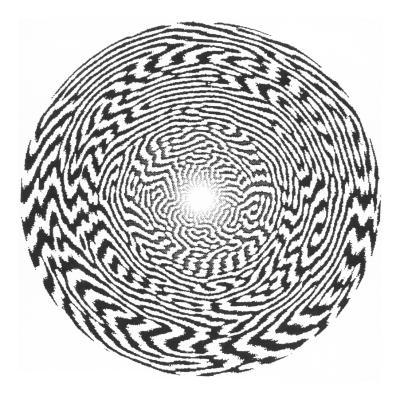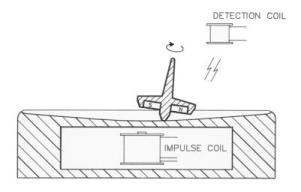Simulation of an hallucination due to a Turing pattern in the visual cortex (External report on the web):

(Report on this work: Wired Magazine, April 1996, 2-3)
The chaotic spinning top:

| 1. | General articles on chaotic phenomena and related subjects. |
| 2. | Numerical modelling of hallucinations, as self-organized patterns in the visual cortex due to long-range neural inhibition versus short-range activation (see figure below). |
| 3. | Simulation of coupled biological cycles using analog circuits. |
| 4. | Analysis of an electrically driven, chaotic spinning top (see figure below; induction in the impulse coil drives the magnetic top). |
| 5. | Chaos induction by modulating with periodic parameter kicking. |
| 6. | Methods for analysis of images of periodic and turbulent waves. |
| 7. | Kinetics and thermodynamics of enzymes. |
| 8. | Simulations of three-dimensional structures in electron-hole-plasmas using partial differential equations. Comparison with evaluations of conductivity measurements. |
| 9. | Control of chaos by pinning discrete sites |
| 10. | Simulations of tectonic processes. |
| 11. | Generalization of the second law of thermodynamics to small systems and short times. |
Simulation of an hallucination due to a Turing pattern in the visual cortex (External report on the web):

(Report on this work: Wired Magazine, April 1996, 2-3)
The chaotic spinning top:

Publications:
M. Schmick, A. Hasselhuhn, Q. Liu, Q. Ouyang and M. Markus, "The fluctuation Theorem in a Sinai-billiard geometry: Predictions and Measurements, Proceedings of the Int. Conf. on Math. and Appl., Bangkok, pp. 39-44 (2007)
M. Schmick, Q. Liu, Q. Ouyang, M. Markus, "Fluctuation theorem for a single particle in a moving billiard: Experiments and simulations", Physical Review E 76, 021115 (2007)
P. Grete and M. Markus, "Multipeaked probability distributions of recurrence times", Physical Review E 75, 036207 (2007)
P. Grete and M. Markus, "Residence Time Distributions For Double-Scroll Attractors", International Journal of Bifurcation and Chaos 17, 1007-1015 (2007)
Schmick, M. and M. Markus, "Fluctuation theorem for a deterministic one-particle system". Physical Review E 70, 065101 (2004).
A. Greilich and M. Markus, "Correlation of entropy with optimal pinning density for the control of spatiotemporal chaos". Nonlinear Phenomena in Complex Systems 6, 541-546 (2003). In the web.
M. Markus, "A scientist's adventures in Postmodernism", Leonardo 33(3), 179-186 (2000)
M. Markus, "Unvorhersagbarkeit in einer deterministischen Welt: Der Tod des Laplaceschen Daemons",in 'Uni-Report 13' (ed. by Rektorat der Universitaet Dortmund 1991), pp. 15-20
M. Markus, "Enzyklopaedie der Ignoranz", GEO-Wissen, 2/1990, p. 176
M. Markus, "Unvorhersagbarkeit -auf verschiedenen Systemebenen- mit Beispielen aus den Naturwissenschaften", Series 'Grenzfragen',Vol. 22 (ed. by P.Weingartner),Alber, Freiburg, pp. 111-146 (1996)
M. Markus, "Numerical models of hallucinations", in: 'Worlds of Consciousness' (ed. by M. Schlichting & H. Leuner), VWB-Verlag, Berlin (1995), pp. 131-140
M. Markus, "Hallucinations: their formation on the cortex can be simulated by a computer", in: 'Caos' (ed. by C.A. Dias and L.S. Ribeiro), Fenda, Lisboa (1994), pp. 65-73
M. Markus, "Halluzinationen: Ihre Entstehung in der Hirnrinde kann im Computer simuliert werden", in: Welten des Bewsstseins (ed. by A. Dittrich, A. Hofmann and H. Leuner), Verlag fuer Wissenschaft und Bildung, Berlin (1994), pp. 133-143
M. Markus, "Chaos" in: 'Herder-Lexikon der Biochemie und Molekularbiolgie", Vol. 1, Herder-Verlag, Freiburg, (1991), pp. 236-240
M. Bode, D. Ruwisch, S. Schuetz, M. Alonso, V. Perez-Munuzuri, V. Perez-Villar and M. Markus, "Parallel analog computation of coupled biological oscillators", Journal of Biological Systems 3, 81-93 (1995)
D. Ruwisch, M. Bode, P. Schuetz and M. Markus, "Parallel analogue computation of coupled cell cycles with electrical oscillators", Phys. Lett. A 186 (1994),p. 137-144
O. Maldonado, M. Markus and B. Hess, "Coexistence of attractors and hysteresis jumps in a chaotic spinning top", Physics Lett. 144, 153-158 (1990)
J. Roessler, M. Kiwi, B. Hess and M. Markus, "Modulated non-linear processes and a novel mechanism to induce chaos", Phys. Rev. A 39, 5954-5960 (1989)
M. Markus, S. Mueller, T. Plesser and B. Hess, "On the recognition of order and disorder", Biological Cybernetics, 57, 187-195 (1987)
M. Markus and Th. Plesser, "Free energy dissipation of the pyruvate kinase reaction has a minimum at cell metabolite concentrations",Biophysical Chemistry 18, 349-352 (1983)
M. Markus, Th. Plesser and M. Kohlmeier, "Analysis of progress curves in enzyme kinetics: bias and convergent set in the differential and in the inte- gral method", Journal of Biochemical and Biophysical Methods 4, 81-90 (1981)
M. Markus, Th. Plesser, A. Boiteux, B. Hess and M. Malcovati, "Analysis of progress curves: Rate law of pyruvate kinase type I from Escherichia coli", Biochem. J. 189, 421-433 (1980)
R. Korenstein, B. Hess and M. Markus, "Cooperativity in the photocycle of purple membrane of Halobacterium halobium with a mechanism of free energy transduction", FEBS Lett. 102(1), 155-161 (1979)
M. Markus and Th. Plesser, "Design and analysis of progress curves in enzyme kinetics", Biochemical Society Transactions 4, 361-364 (1976)
M. Markus and K. Huebner, "Sausage instability of the z-pinch in n-InSb", Zeitschrift fuer Physik B21, 333-337 (1975)
M. Markus and K. Huebner, "Determination of the time evolution of the z-pinch in n-InSb from conductivity measurements", Phys. Lett. 29A, 392-393 (1969)
K. Huebner, H. Zuber and M. Markus, "Some remarks on the z-pinch onset in an electron-hole-plasma in n-InSb", Phys. Lett. 25A, 62-64 (1967)